 
THE COLLECTIONS
ARCHAEOLOGY - South Folk of the East Angles 410 - 1066
 As the rule of Rome in Britain finally collapsed in the early 5th
century, Anglian settlers from around Holland and the Jutland
Peninsula migrated into the region, bringing with them a new
culture. Beliefs, language, art, the economy, all developed and adapted once
more. At West Stow, 7 miles from Moyse's Hall Museum, an Anglo-Saxon
village of this period has been excavated and reconstructed; today one can walk
amongst those buildings as they may have looked 1500 years ago. Meanwhile in
the museum, some of the thousnads of finds from the village and nearby cemetery are
displayed. Funerary evidence tells much about life as well as death,
with one human leg bone disfigured by arthritis, another skull displaying signs of
(healed) spear wounds; pagan grave goods from dress fastenings to swords: all
add to the picture of lives that could be both violent and short but were also
creative and sophisticated. Christianity became widespread after the 7th to 8th
centuries; the monastery at Bedricesworth (Bury St Edmunds) was the
first of many until Edmund, King of the East Angles was slain fighting the Danes
in the Battle of Haegelisdun (probably Hellesden, in Bradfield St Clare). Danish
rule of East Anglia followed as did Edmunds importance as a Christian martyr.
In the 10th century his remains were brought to the abbey in Bury St Edmunds
which now became a focus of sacred pilgrimage, injecting new wealth and
importance into the abbey and town alike. Today this story, and some of the
evidence for it, can be found in the abbey itself at Samson's Tower.
As the rule of Rome in Britain finally collapsed in the early 5th
century, Anglian settlers from around Holland and the Jutland
Peninsula migrated into the region, bringing with them a new
culture. Beliefs, language, art, the economy, all developed and adapted once
more. At West Stow, 7 miles from Moyse's Hall Museum, an Anglo-Saxon
village of this period has been excavated and reconstructed; today one can walk
amongst those buildings as they may have looked 1500 years ago. Meanwhile in
the museum, some of the thousnads of finds from the village and nearby cemetery are
displayed. Funerary evidence tells much about life as well as death,
with one human leg bone disfigured by arthritis, another skull displaying signs of
(healed) spear wounds; pagan grave goods from dress fastenings to swords: all
add to the picture of lives that could be both violent and short but were also
creative and sophisticated. Christianity became widespread after the 7th to 8th
centuries; the monastery at Bedricesworth (Bury St Edmunds) was the
first of many until Edmund, King of the East Angles was slain fighting the Danes
in the Battle of Haegelisdun (probably Hellesden, in Bradfield St Clare). Danish
rule of East Anglia followed as did Edmunds importance as a Christian martyr.
In the 10th century his remains were brought to the abbey in Bury St Edmunds
which now became a focus of sacred pilgrimage, injecting new wealth and
importance into the abbey and town alike. Today this story, and some of the
evidence for it, can be found in the abbey itself at Samson's Tower.
|


